Refurbishing a much-loved antique Chesterfield sofa
Your antique Chesterfield – a member of the family …
The leather hide that often covers an antique Chesterfield is a natural material. And when it ages, like our skin, it can become visually far more interesting, and characterful. Its surface will stretch and craze, and the once richly dyed leather, after exposure to the elements, will fade. All these imperfections add to the decorative appeal of an antique Chesterfield. However, depending on your viewpoint, when the seat starts to sag, and the springs can be felt, it may be time for some intervention. And this is why the owners of an old Chesterfield, that they dearly loved, like a member of their family, came in search of our help. They wanted to keep the original leather, which was so much part of its character but they were also looking to refurbish what lay beneath.
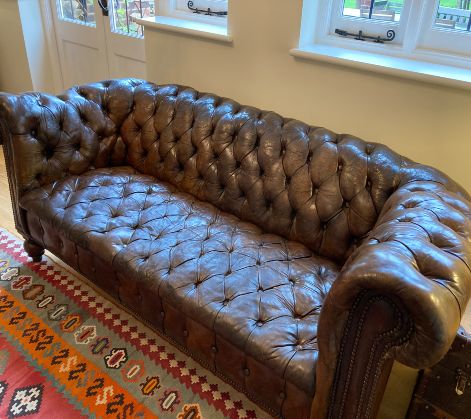
A visual feast
An antique Chesterfield is probably the most recognisable of all the period soft furnishings. Its rolled arms and back, sit comfortably on one level. The tufted top edge draws your gaze down over the tight, often richly dyed, pleated and deep-buttoned hide-covered body. If this veritable moonscape of uniform peaks and troughs were not sufficient, a myriad of antique brass upholstery nails or studs often provides further decoration to its arms and skirt. The whole visual feast is supported by turned, tapered, or swept hardwood feet with brass castors. The popularity of the antique Chesterfield has grown in line with the ongoing refinement of its design, during the 19th and Early 20th Centuries. This was a period of superior craftsmanship, invention, and great advancements in improving the ergonomic qualities of soft furnishings.
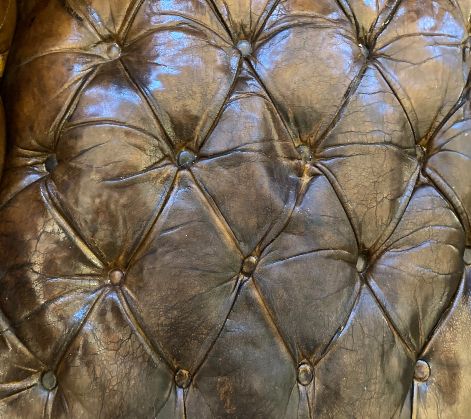
Breathing new life into an old Chesterfield
From the outset, we knew the main challenge facing the upholsterer, apart from protecting the original delicate leather, was its correct re-positioning once the newly upholstered seat was in place. The pleats needed to follow their original folds; any more than a marginal difference would look unsightly, as the undyed leather would be exposed.
The images show some of the different stages that needed to be undertaken to refurbish the antique Chesterfield, but here is a more detailed explanation –
- Careful removal of the existing buttons – to keep the originality and character we hoped to re-use them.
- Placed a layer of calico over the seat – this was to protect the fragile leather during the reupholstery process.
- The upholstery to the lower back and arms was lifted and all the fixings that held the seat in place were removed.
- The leather seat covering was rolled into the calico and secured.
- The existing upholstery was removed
- Re-webbed, sewed in and lashed the new set of springs.
- Sewed in a layer of hessian, on top of which a layer of core fibre and rubberised hair was added.
- Holes were cut to take the original buttons.
- A layer of cotton felt, and a layer of Dacron was added.
- Temporarily, the seat cover was tacked back and whilst the seat was rebuttoned (all but one of the original buttons were able to be saved).
- The seat was permanently tacked off.
- The arms and back were reinstated, and to finish, a layer of canvas was tacked to the underside of the antique Chesterfield.
- The surface was fed with hide care cream, to restore a degree of suppleness to the dry and friable leather.
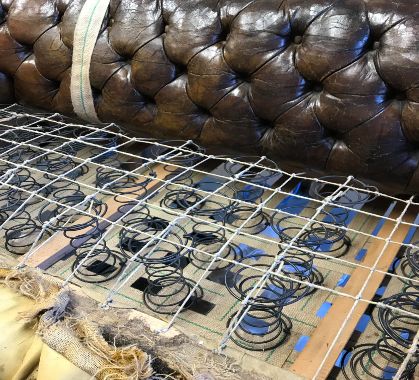
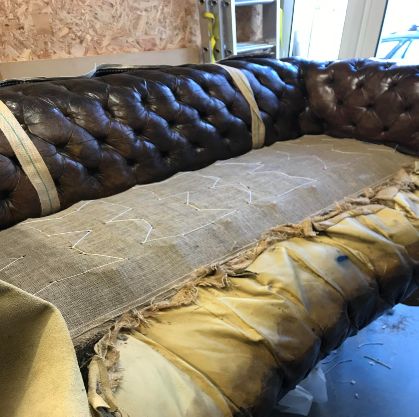
Now, the seat had been refurbished, it was time to deliver the old Chesterfield back to its rightful place within the family home. It wasn’t long after the trusted couriers had left that we received a phone call from the owners to congratulate us on our work, and to let us know how pleased they were with the results.
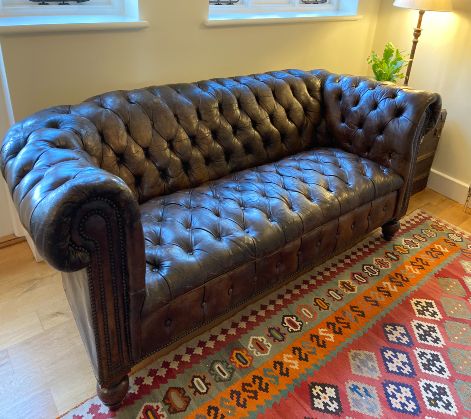
Our re-upholstery service
If your antique Chesterfield, or for that matter, any piece of period upholstered furniture, requires some re-upholstery or refurbishment, you are welcome, via our contact page, to send us some images, measurements and a brief outline of what you would like us to do. This will enable us to start the process of preparing a quotation on your behalf. I hope you have found this article informative, and we look forward to answering any questions you may have.

